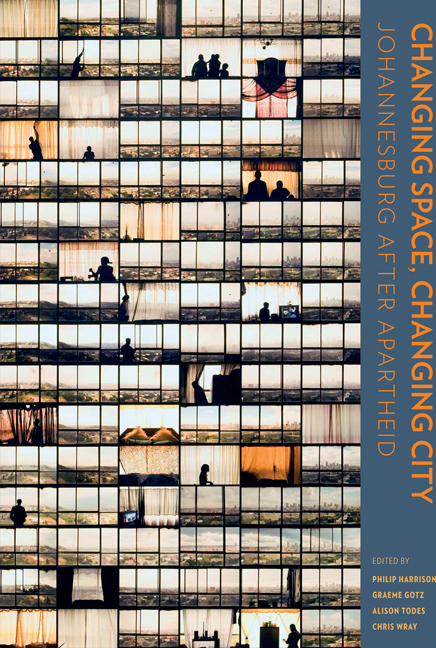Book contents
- Frontmatter
- Contents
- Preface
- Cartography
- 1 Materialities, subjectivities and spatial transformation in Johannesburg
- Section A The macro trends
- Section B Area-based transformations
- Section C Spatial identities
- 23 Footprints of Islam in Johannesburg
- 24 Being an immigrant and facing uncertainty in Johannesburg: The case of Somalis
- 25 On ‘spaces of hope’: Exploring Hillbrow's discursive credoscapes
- 26 The Central Methodist Church
- 27 The Ethiopian Quarter
- 28 Urban collage: Yeoville
- 29 Phantoms of the past, spectres of the present: Chinese space in Johannesburg
- 30 The notice
- 31 Inner-city street traders: Legality and spatial practice
- 32 Waste pickers/informal recyclers
- 33 The fear of others: Responses to crime and urban transformation in Johannesburg
- 34 Black urban, black research: Why understanding space and identity in South Africa still matters
- Contributors
- Photographic credits
- Acronyms
- List of plates
- List of figures
- List of tables
- Index
23 - Footprints of Islam in Johannesburg
from Section C - Spatial identities
Published online by Cambridge University Press: 20 April 2018
- Frontmatter
- Contents
- Preface
- Cartography
- 1 Materialities, subjectivities and spatial transformation in Johannesburg
- Section A The macro trends
- Section B Area-based transformations
- Section C Spatial identities
- 23 Footprints of Islam in Johannesburg
- 24 Being an immigrant and facing uncertainty in Johannesburg: The case of Somalis
- 25 On ‘spaces of hope’: Exploring Hillbrow's discursive credoscapes
- 26 The Central Methodist Church
- 27 The Ethiopian Quarter
- 28 Urban collage: Yeoville
- 29 Phantoms of the past, spectres of the present: Chinese space in Johannesburg
- 30 The notice
- 31 Inner-city street traders: Legality and spatial practice
- 32 Waste pickers/informal recyclers
- 33 The fear of others: Responses to crime and urban transformation in Johannesburg
- 34 Black urban, black research: Why understanding space and identity in South Africa still matters
- Contributors
- Photographic credits
- Acronyms
- List of plates
- List of figures
- List of tables
- Index
Summary
Religious identities are profoundly influencing place-making and socio-spatial organisation of twenty-first-century cities around the world and they are in turn being hybridised by their contact with the urban environments in which they locate. Islam in particular has become the focus of much global geopolitical debate and research in the post-9/11 world. Its spatial footprint across the continents has become a visible public part of major cities and towns. Islam in Western Europe and North America has over the past two decades come to occupy an increasingly public presence in the city. Muslim communities, long hidden from view by virtue of their small numbers, are emerging more visibly in the spatial fabric of these cities.
While there seems to be a significant body of academic literature discussing placemaking and built environments in cities of the Muslim world, there are fewer texts that explore the urban environment dynamics of the Muslim diaspora. To date, there has been a dearth of academic work published on Islam's spatial footprint in South African cities, including Johannesburg. Tayob (1995) discusses the development of Islam in South Africa and shows how its resurgence plays out in different parts of the country. His treatment of the spatial dynamics is only tangential to his overall argument. In a different vein, Jeppie (2001) is mainly concerned with the Cape Muslim identity, with a mono-focus on the Western Cape. Paulsen's (2003) principal area of enquiry is on the syncretic beliefs and practices of Malays in Gauteng. While it has a strong spatial emphasis, it examines only Muslims who live in coloured group areas such as Westbury, Bosmont, Eldorado Park and Ennerdale. Sadouni (2012) examines the presence of the Somali community in Mayfair, Johannesburg. Although her work (see Chapter 24) has a strong socio-spatial emphasis, it focuses on a new and still small component of the wider Muslim community in the city. In a similar vein, Fakude (2002) traces the development of Islam in the townships, focusing briefly on Soweto. He is concerned with developing a socio-political critique of relations between Muslims in the townships and the ‘established’ Muslim communities – mainly those of Indian or Malay origin. It is clear that the subject is under-researched and this contribution to the literature of urban spatial planning aims to at least add one fresh perspective and stimulate additional scholarship.
- Type
- Chapter
- Information
- Changing Space, Changing CityJohannesburg after apartheid, pp. 456 - 480Publisher: Wits University PressPrint publication year: 2014



